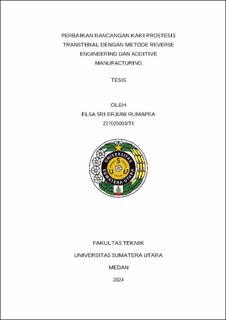Perbaikan Rancangan Kaki Prostesis Transtibial dengan Metode Reverse Engineering dan Additive Manufacturing
Improvement of Transtibial Prosthetic Leg by Using Reverse Engineering and Additive Manufacturing

Date
2024Author
Rumapea, Elsa Sri Erjuni
Advisor(s)
Ginting, Rosnani
Ishak, Aulia
Metadata
Show full item recordAbstract
A prosthetic is a tool to replace a missing function or part of the body. There are various kinds of prosthetics available in Indonesia, one of them is the transtibial prosthetic leg. There are twelve problems with the transtibial prosthetic legs that exist today: the products are not easy to mount, the heavy products, the cover is easy to break, the socket is smooth, it smells, the stump is sweaty and scratched, it's already on the slopes, it is difficult to wear footwear, the palms are loose, they are broken, and they change color. To solve these problems, the methods of Reverse Engineering and Additive Manufacturing are used. The aim of the application of both methods is to obtain a proposal for a plan of improvement that matches the needs of the user. While additive manufacturing is a method used for the process of 3D printing a design product by adding materials gradually. The combination of these two methods allows the construction of the leg prosthesis under the knee more precisely and according to the needs of the user. The design applied is endoskeletal to facilitate the process of 3D printing. The application of endoskeletal design according to the prosthetic orthologist has the advantage that when one part of the design is broken, it makes it easy to replace only that part. As for the design proposal of the transtibial prosthetic foot that was implemented in this study, the transitibial protetic leg consists of three parts of the foot, shank, and socket with dimensions after assembly 24 x 15 x 24 Cm. The design proposed prosthetic leg weighs 1,052 grams and 677 grams after 3D printing with polylactic acid material.
Collections
- Master Theses [185]
